Volume 30, Number 8—August 2024
Research
Potential of Pan-Tuberculosis Treatment to Drive Emergence of Novel Resistance
Figure 1

Figure 1. Treatment pathways for new TB patients in study of potential of pan-TB treatment to drive emergence of novel resistance, comparing a pan-TB treatment scenario (A) with the standard-of-care scenario (B). Retreatment pathways are shown in Appendix Figure 1. BR-TB, diarylquinoline-resistant TB; RR-TB, rifampin-resistant TB; RS-TB, rifampin-susceptible TB; TB, tuberculosis; XR-TB, TB resistant to additional novel drug X; R DST, rifampin drug-susceptibility testing; B DST, diarylquinoline susceptibility testing; X DST, other novel drug (or drugs) susceptibility testing.
Page created: June 21, 2024
Page updated: July 20, 2024
Page reviewed: July 20, 2024
The conclusions, findings, and opinions expressed by authors contributing to this journal do not necessarily reflect the official position of the U.S. Department of Health and Human Services, the Public Health Service, the Centers for Disease Control and Prevention, or the authors' affiliated institutions. Use of trade names is for identification only and does not imply endorsement by any of the groups named above.